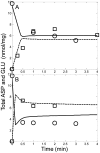Modeling mitochondrial bioenergetics with integrated volume dynamics
- PMID: 20052270
- PMCID: PMC2793388
- DOI: 10.1371/journal.pcbi.1000632
Modeling mitochondrial bioenergetics with integrated volume dynamics
Abstract
Mathematical models of mitochondrial bioenergetics provide powerful analytical tools to help interpret experimental data and facilitate experimental design for elucidating the supporting biochemical and physical processes. As a next step towards constructing a complete physiologically faithful mitochondrial bioenergetics model, a mathematical model was developed targeting the cardiac mitochondrial bioenergetic based upon previous efforts, and corroborated using both transient and steady state data. The model consists of several modified rate functions of mitochondrial bioenergetics, integrated calcium dynamics and a detailed description of the K(+)-cycle and its effect on mitochondrial bioenergetics and matrix volume regulation. Model simulations were used to fit 42 adjustable parameters to four independent experimental data sets consisting of 32 data curves. During the model development, a certain network topology had to be in place and some assumptions about uncertain or unobserved experimental factors and conditions were explicitly constrained in order to faithfully reproduce all the data sets. These realizations are discussed, and their necessity helps contribute to the collective understanding of the mitochondrial bioenergetics.
Conflict of interest statement
The authors have declared that no competing interests exist.
Figures









Similar articles
-
Integrated computational model of the bioenergetics of isolated lung mitochondria.PLoS One. 2018 Jun 11;13(6):e0197921. doi: 10.1371/journal.pone.0197921. eCollection 2018. PLoS One. 2018. PMID: 29889855 Free PMC article.
-
A computational model integrating electrophysiology, contraction, and mitochondrial bioenergetics in the ventricular myocyte.Biophys J. 2006 Aug 15;91(4):1564-89. doi: 10.1529/biophysj.105.076174. Epub 2006 May 5. Biophys J. 2006. PMID: 16679365 Free PMC article.
-
An integrated model of cardiac mitochondrial energy metabolism and calcium dynamics.Biophys J. 2003 Apr;84(4):2734-55. doi: 10.1016/S0006-3495(03)75079-6. Biophys J. 2003. PMID: 12668482 Free PMC article.
-
The complex interplay between mitochondrial dynamics and cardiac metabolism.J Bioenerg Biomembr. 2011 Feb;43(1):47-51. doi: 10.1007/s10863-011-9332-0. J Bioenerg Biomembr. 2011. PMID: 21258852 Free PMC article. Review.
-
Lipophilic triphenylphosphonium cations as tools in mitochondrial bioenergetics and free radical biology.Biochemistry (Mosc). 2005 Feb;70(2):222-30. doi: 10.1007/s10541-005-0104-5. Biochemistry (Mosc). 2005. PMID: 15807662 Review.
Cited by
-
Integrated computational model of the bioenergetics of isolated lung mitochondria.PLoS One. 2018 Jun 11;13(6):e0197921. doi: 10.1371/journal.pone.0197921. eCollection 2018. PLoS One. 2018. PMID: 29889855 Free PMC article.
-
Kinetic modelling of β-cell metabolism reveals control points in the insulin-regulating pyruvate cycling pathways.IET Syst Biol. 2023 Dec;17(6):303-315. doi: 10.1049/syb2.12077. Epub 2023 Nov 8. IET Syst Biol. 2023. PMID: 37938890 Free PMC article.
-
Postnatal growth restriction alters myocardial mitochondrial energetics in mice.Exp Physiol. 2024 Apr;109(4):562-575. doi: 10.1113/EP091304. Epub 2024 Jan 5. Exp Physiol. 2024. PMID: 38180279 Free PMC article.
-
Analysis of the kinetics and bistability of ubiquinol:cytochrome c oxidoreductase.Biophys J. 2013 Jul 16;105(2):343-55. doi: 10.1016/j.bpj.2013.05.033. Biophys J. 2013. PMID: 23870256 Free PMC article.
-
Modeling the calcium sequestration system in isolated guinea pig cardiac mitochondria.J Bioenerg Biomembr. 2013 Jun;45(3):177-88. doi: 10.1007/s10863-012-9488-2. Epub 2012 Nov 22. J Bioenerg Biomembr. 2013. PMID: 23180139 Free PMC article.
References
-
- Wu F, Yang F, Vinnakota KC, Beard DA. Computer modeling of mitochondrial tricarboxylic acid cycle, oxidative phosphorylation, metabolite transport, and electrophysiology. J Biol Chem. 2007;282:24525–24537. - PubMed
-
- Nguyen MH, Dudycha SJ, Jafri MS. Effect of Ca2+ on cardiac mitochondrial energy production is modulated by Na+ and H+ dynamics. Am J Physiol Cell Physiol. 2007;292:C2004–2020. - PubMed
-
- Korzeniewski B, Zoladz JA. A model of oxidative phosphorylation in mammalian skeletal muscle. Biophys Chem. 2001;92:17–34. - PubMed
-
- Nazaret C, Heiske M, Thurley K, Mazat JP. Mitochondrial energetic metabolism: a simplified model of TCA cycle with ATP production. J Theor Biol. 2009;258:455–464. - PubMed
Publication types
MeSH terms
Substances
LinkOut - more resources
Full Text Sources
Other Literature Sources
Research Materials

